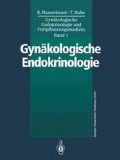Zusammenfassung
Die physiologischen Konzentrationen der meisten Hormone liegen im Serum in der Größenordnung von 10−6–10−12 g/ml. Diese geringen Konzentrationen stellen hohe Anforderungen an die Analytik und verhinderten lange Zeit die qualitative und quantitative Bestimmung der einzelnen Hormone. Die biologische Aktivität der Hormone hat entscheidend zu ihrer Entdeckung und Isolierung beigetragen, denn mittels einer biologischen Bestimmungsmethode am Tier konnten die Hormone angereichert und schließlich in reinem Zustand erhalten werden.
Access this chapter
Tax calculation will be finalised at checkout
Purchases are for personal use only
Preview
Unable to display preview. Download preview PDF.
Literatur
Albert A (1959) Symposium on endocrine assays gonadotropins. Fertil Steril 10: 60–83
Allen E, Doisy EA (1923) An ovarian hormone: Preliminary report on its localization, extraction and partial purification, and action in test animals. JAMA 81: 819–821
Aschheim S, Zondek B (1928) Schwangerschaftsdiagnose aus dem Harn. Klin Wochenschr 7: 8–9
Astwood EB (1938) A six-hour assay for the quantitative determination of estrogen. Endocrinology 23: 25–31
Bolton AE, Hunter WM (1973) The labeling of proteins to high specific radioactivities by conjugation to a J-125-containing acylating agent. Biochem J 133: 529–539
Brown JB (1955) A chemical method for the determination of oestriol, oestrone, and oestradiol in human urine. Biochem J 60: 185–193
Collins WP, Sommerville JF (1964) Quantitative determination of progesterone in human plasma by thin-layer and gas-liquid radiochromatography. Nature (Lond) 203: 836–839
Ding YQ, Huhtaniemi I (1991) Preponderance of basic isoforms of serum luteinizing hormone ( LH) is associated with the high bio/immuno ratio of LH in healthy women and in women with policystic ovarian disease. Human Reproduction 6: 346–350
EORTC-Breast Cancer Cooperative Group (1973) Standards for the assessment of estrogen receptors in human breast cancer. Eur J Cancer 9: 379–381
EORTC-Breast Cancer Cooperative Group (1980) Revision of the standards for the assessment of hormone receptors in human breast cancer. Eur J Cancer 16: 1513–1515
Högel B, Jawny J, Eiermann W (1982) Fluoreszenzmikroskopischer Nachweis von Östrogen-und Gestagenrezeptoren im Mammakarzinom. Tumor Diagnostik 3: 6–8
Hon EM, Morris J (1956) Further experience with the tood method of testing for chorionic gonadotropin in normal and disturbed pregnancy. J Clin Endocrinol Metab 16: 1354–1363
Hooker CW, Forbes TR (1949) Specificity of the intrauterine test for progesterone. Endocrinology 45:71— 74
Hunter WM, Greenwood FC (1962) Preparation of iodine-131 labeled human growth hormone of high specific activity. Nature 194: 495–496
Jensen EV (1981) Hormone dependency of breast cancer. Cancer 47: 2319–2326
Klinefelter HF, Albright F, Griswold GC (1943) Experience with a quantitative test for normal or decreased amounts of follicle stimulating hormone in the urine in endocrinological diagnosis. J Clin Endocrinol 3: 529–544
Klingler W (1982) Übersicht über biochemische Grundlagen des Enzymimmunoassays. Nuclear Med 21: 161–163
Klingler W, Fricke H, Gadow A, Haupt O, Postel G von, Stras-burger CJ, Wood WG (1983) Lumineszenz-Immunoassays-Eine Alternative zum Radioimmunoassay. NucCompact 14: 90–95
Köhler G, Milstein C (1975) Continuous cultures of fused cells secreting antibody of predefined specificity. Nature 256: 495–497
Lindner Ch, Lichtenberg V, Braendle W, Bettendorf G (1991) Bioactivity and immunoreactivity of gonadotropins during GnRH-agonist induced desensitization. Acta Endocrinologica 124, 1: 9.
Marchalonis JJ (1969) An enzymatic method for the trace iodination of immunoglobulins and other proteins. Biochem J 113: 299–305
McCullagh EP, McCullagh DR, Hinken NF (1933) Diagnosis and treatment of hypogonadodism in the male. Endocrinology 17: 49–63
Moore CR, Gallagher TF (1930) Seminal vesicle and prostata function as a testis hormone indicator. Am J Anat 45: 39–69
Pertuschek LP, Tobin EM, Gaetjens E, Carter AC, Degensheim GA, Bloom ND, Brigati DJ (1980) Histochemical assay of estrogen and progesterone receptors in breast cancer. Cancer 46: 2896–2901
Philibert D, Raynaud JP (1974) Binding of progesterone and R 5020, a highly potent progestin, to human endometrium and myometrium. Contraception 10: 457–466
Preedy JRK, Aitken EH (1961) Column partition chromatography of estrone, estradiol-17ß, and estriol in phenolic extracts of urine: fluorescence characteristics of interfering material. J Biol Chem 236: 1297–1299
Press MF, Greene GL (1984) Methods in laboratory investigation: an immunocytochemical method for demonstrating estrogen receptor in human uterus using monoclonal antibodies to human estrophilin. Lab Invest 50: 480–486
Riddle O, Bates RWD, Dykshorn SW (1933) The preparation, identification and assay of prolactin-a hormone of the anterior pituitary. Am J Physiol 105: 191–216
Riondel A, Tait JF, Tait SAS, Gut M, Little B (1965) Estimation of progesterone in human peripheral blood using 35S-Thiosemicarbazide. J Clin Endocrinol 25: 229–242
Sayers MA, Sayers G, Woodbury LA (1948) The assay of adrenocorticotrophic hormone by the adrenal ascorbic acid-depletion method. Endocrinology 42: 379–393
Siekmann L, Siekmann A, Breuer H (1978) Isotope dilution mass spectrometry of oestriol and oestradiol-an approach to definitive methods. Z Anal Chem 290: 122–123
Scatchard G (1949) The attractions of proteins for small molecules and ions. Ann NY Acad Sci 51: 660–672
Vaitukaitis JL, Robbins JB, Nieschlag E, Ross GT (1971) A method for producing specific antisera with small doses of immunogen. J Clin Endocrinol Metab 33: 988–991
Wittliff JL, Beatty BW, Baker DT, Savlov ED, Cooper RA (1977) Clinical significance of molecular forms of estrogen receptors in human breast cancer. In: Vermeulen A, Jungblut P, Klopper A (eds) Research on steroids VII. Elsevier, North Holland, Amsterdam, pp 393–403
Wotiz HH, Chattoraj SC (1965) In: Lipsett MB (ed) Gas chromatography of steroids in biological fluids. Plenum, New York, p 195
Yalow RS, Berson SA (1959) Assay of plasma insulin in human subjects by immunological methods. Nature 184: 1648–1649
Zander J, Simmer H (1954) Die chemische Bestimmung von Progesteron in organischen Substraten. Klin Wochenschr 32: 529–534
Rights and permissions
Copyright information
© 1994 Springer-Verlag Berlin Heidelberg
About this chapter
Cite this chapter
Klinga, K. (1994). Bestimmung von Hormonen und Hormonrezeptoren. In: Gynäkologische Endokrinologie und Fortpflanzungsmedizin. Springer, Berlin, Heidelberg. https://doi.org/10.1007/978-3-662-07635-4_2
Download citation
DOI: https://doi.org/10.1007/978-3-662-07635-4_2
Publisher Name: Springer, Berlin, Heidelberg
Print ISBN: 978-3-662-07636-1
Online ISBN: 978-3-662-07635-4
eBook Packages: Springer Book Archive

